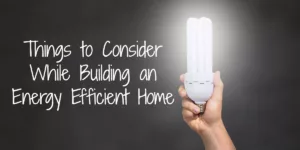Building a home is everyone’s dream. A garden where your kids can play, backyard pool and cozy rooms are some of the things that comes to your mind. But building an energy efficient home is something you should think about as well. We are talking about a home that is energy saver and has a set of alternatives to use over appliances that consume lots of energy. Let’s jump to five things to consider while building an energy efficient home.
1. Choose Energy Efficient Appliances & Electronics
Not only do electronics and appliances take a lot of space in your home, but they also consume energy, and the amount of energy consumed depends on which products you choose. If you live in Texas, consider getting power from the electricity providers there. You can check Texas electricity rates to get an idea of what you will be paying and saving in case you go for appliances that can save energy.
Most electronics and appliance makers are embracing the technology of energy efficiency, and you can find plenty of energy efficient dishwashers, dryers, computers, and other equipment. By reducing power output, you will have achieved the first step of having an energy efficient home.
2. Plant Trees Around Your House
You probably never thought about this, but sometimes, nature can be a better alternative to using electricity. Planning your landscape can play a crucial role in saving energy. You can plant deciduous trees depending on your location and from where the sun rises and sets.
Those trees can provide shade over your house during summer and ensure your home stays cool. Then autumn will come, leaves will fall, and winter will be around the corner. The winter sun will shine through the leafless branches and heat your home a little.
3. Install Cool Roofs
A cool roof is made of materials such as slate, tiles, or clay and they reduce the amount of heat entering the house from the roof by reflecting the sunlight. Another option can be green roofs such as thatched glasses or simple plant cover. You can also plant some crawling plants.
Asphalt shingles or aluminum sheets usually absorb the sun’s heat which will raise your house’s temperature such that you will want to stay outside or use your AC. Cool roofs improve comfort and cut energy bills. Furthermore, it will take you a long time before you start worrying about repairing your rooftop.
4. Choose Your Exterior Colors Wisely!
The color of your house affects the temperatures in your home, especially at day time. A light-colored exterior will help your house stay cooler while darker colors will conserve heat. The location of your house depends though. If you live in the poles, a house that conserves heat is necessary, but if the hot sun passes over your house every day, rethink about painting the outside of your home with a bright color.
A house located in a warm climate deserves a light-colored exterior while a house built in colder climates should have exteriors that are dark. For a home in a moderate climate, well, a light-colored exterior is more convenient.
5. Go for LED Lighting
Lastly, lighting is an essential aspect of your home, and if you intend to build a house that saves energy, you can go for LED lightings. Fluorescent lights are amazing and beautiful, but LED is the technology of the future as far as lighting is concerned. LED bulbs consume less electricity than any other form of lighting.
LED lights will save you a lot of money when it comes to electricity bills, and they stay over a dozen years before replacement. What’s more, you can fit them in any design you wish.
Conclusion
It’s easier to build an energy efficient home than renovating and adjusting an already existing building to conserve energy. Ensure that your engineer has the same goals as you and understands what having such a home means.








